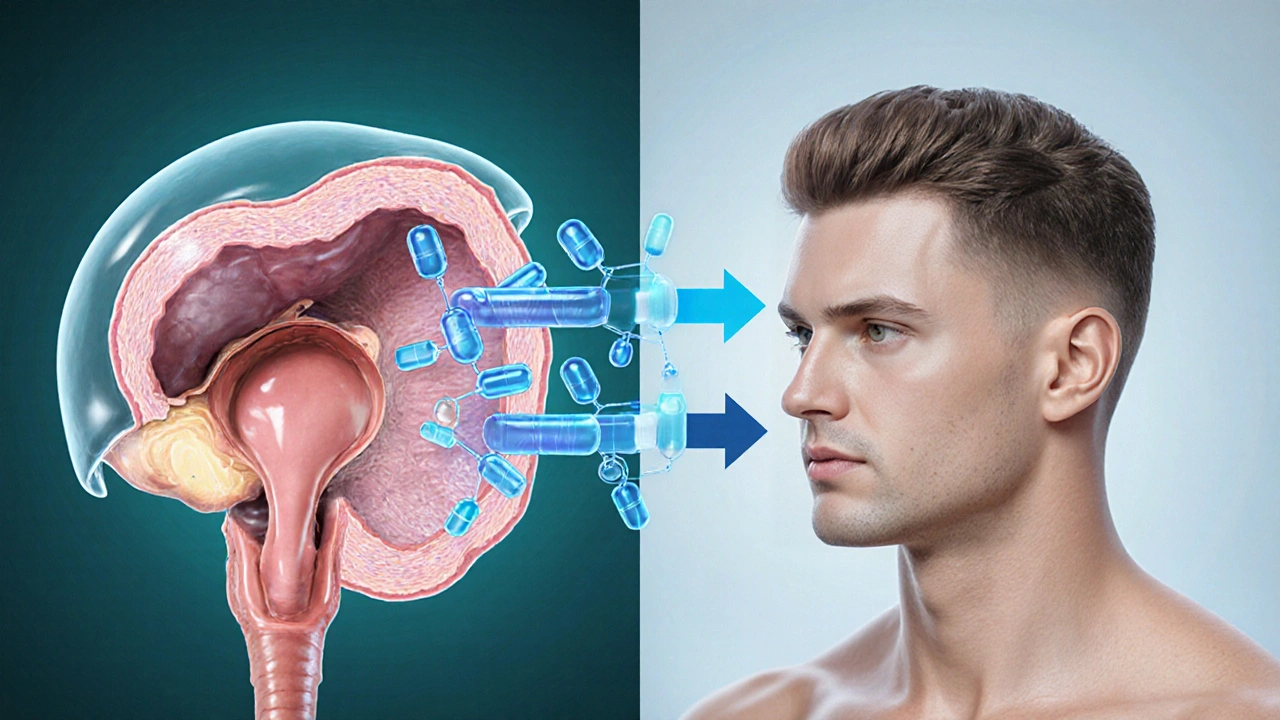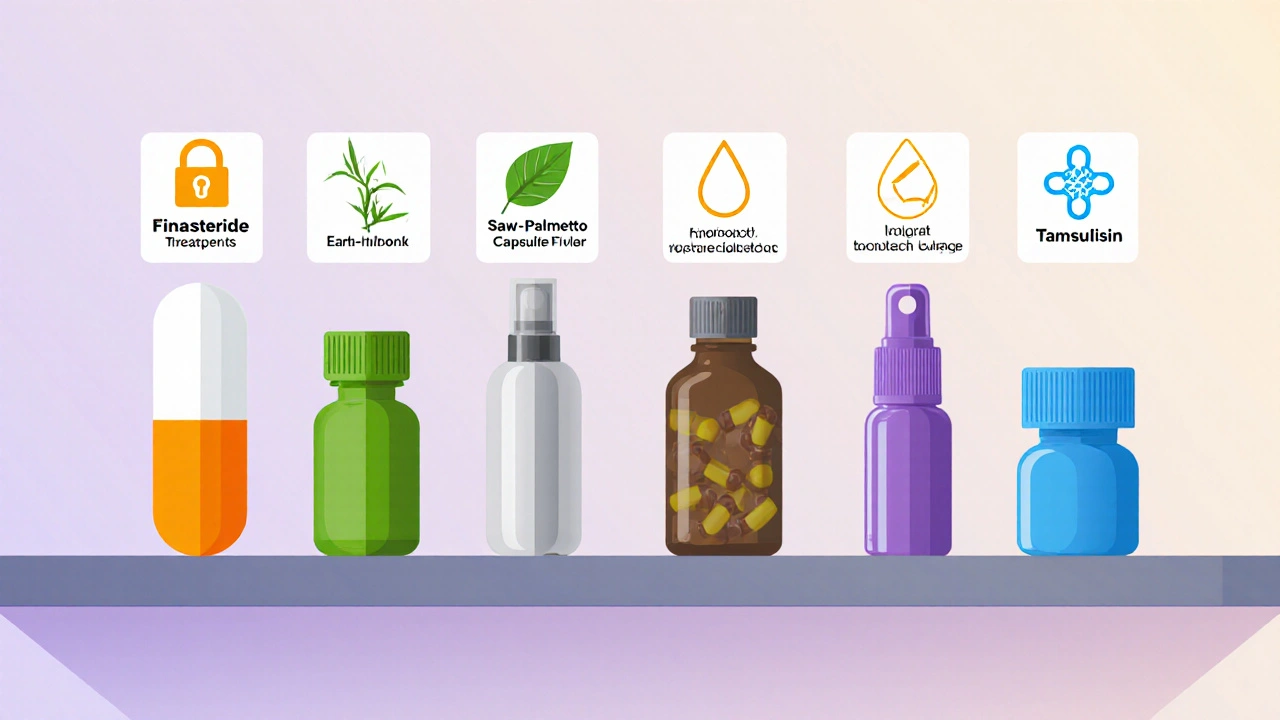 Oct, 12 2025
Oct, 12 2025
BPH & Hair Loss Treatment Selector
Choose Your Condition
How severe are your symptoms?
What matters most to you?
Your Recommended Treatment
Treatment Comparison
| Feature | ||
|---|---|---|
| How it works | ||
| Effectiveness | ||
| Typical cost (US) | ||
| Common side effects |
Important Considerations
Remember: Dutasteride is FDA-approved for BPH but is often used off-label for hair loss. Always discuss your options with a healthcare provider who can consider your full medical history.
When it comes to treating benign prostatic hyperplasia (BPH) and male‑pattern hair loss, Dutasteride is a prescription drug that blocks the conversion of testosterone into dihydrotestosterone (DHT) by inhibiting both typeI and typeII 5‑alpha‑reductase enzymes. Because DHT drives prostate growth and hair‑follicle mini‑aturation, Dutasteride can shrink an enlarged prostate and slow hair loss. But it isn’t the only option on the market, and choosing the right therapy means looking at efficacy, safety, cost, and personal preferences.
Key Takeaways
- Dutasteride is the most potent 5‑alpha‑reductase inhibitor available, acting on two enzyme subtypes.
- Finasteride is less potent but widely used for both BPH and hair loss, with a long safety record.
- Natural supplements like Saw Palmetto work weaker and lack robust clinical backing.
- Topical Minoxidil tackles hair loss via a different pathway (vasodilation) and can be combined with oral agents.
- Spironolactone and Tamsulosin treat BPH or androgenic symptoms through hormone antagonism or smooth‑muscle relaxation, not DHT reduction.
How Dutasteride Works
The drug belongs to the class of 5‑alpha‑reductase inhibitors. By blocking both typeI (found in skin and liver) and typeII (predominantly in the prostate and hair follicles), it reduces circulating DHT by up to 90%. Lower DHT levels shrink prostate tissue, improve urinary flow, and stabilize hair‑shaft mini‑aturation. The typical dose for BPH is 0.5mg daily; for off‑label hair‑loss treatment, the same dose is used.
What to Compare
When weighing Dutasteride against alternatives, consider the following criteria:
- Mechanism of action - does it target DHT directly, or work via another pathway?
- Clinical efficacy - how much symptom improvement is documented in trials?
- Safety profile - which side effects are common, and how severe are they?
- Regulatory status - FDA‑approved, prescription‑only, or over‑the‑counter?
- Cost & insurance coverage - average wholesale price and typical copay.
- Convenience - pill versus topical, dosing frequency, need for monitoring.
Side‑by‑Side Comparison Table
| Attribute | Dutasteride | Finasteride | Saw Palmetto | Minoxidil (topical) | Spironolactone | Tamsulosin |
|---|---|---|---|---|---|---|
| Mechanism | Dual 5‑α‑reductase inhibitor (typeI+II) | Selective typeII 5‑α‑reductase inhibitor | Weak, reversible 5‑α‑reductase inhibition (plant extract) | Vasodilator; opens potassium channels in scalp vessels | Androgen receptor antagonist; also a potassium‑sparing diuretic | α‑1 adrenergic blocker; relaxes prostate smooth muscle |
| Primary FDA‑approved uses | BPH (male prostate enlargement) | BPH and androgenic alopecia (hair loss) | Dietary supplement - marketed for prostate health | Androgenic alopecia (both men and women) | Off‑label for female hirsutism and acne; not for BPH | BPH symptom relief (urinary flow) |
| Typical dose | 0.5mg once daily | 1mg (hair loss) or 5mg (BPH) daily | 320mg extract twice daily | 2% solution, twice daily application | 25‑100mg daily (women) or 50‑200mg (men) | 0.4mg once daily |
| Efficacy (BPH volume reduction) | ~20-30% reduction in prostate volume after 6months | ~10-15% reduction | Data mixed; modest 5‑10% reduction in some studies | N/A (hair‑focused) | N/A (not a DHT reducer) | Improves urinary flow by ~30% within 4weeks |
| Hair‑loss benefit (percentage of patients) | ~30% see hair‑count increase; comparable to finasteride | ~25‑30% response rate | ~10‑15% in small trials | ~40‑50% see regrowth with consistent use | Variable; higher benefit in women with hormonal acne | N/A |
| Common side effects | Decreased libido, ejaculation disorder, breast tenderness | Similar but milder; occasional erectile dysfunction | Gastrointestinal upset, possible interaction with blood thinners | Scalp irritation, itching, temporary hair shedding | Hyperkalemia, menstrual irregularities (women) | Dizziness, orthostatic hypotension |
| Cost (US average retail) | $90‑$150 per month (generic) | $30‑$80 per month (generic) | $20‑$40 per month (supplement) | $25‑$60 per month (brand) | $15‑$40 per month (generic) | $25‑$45 per month (generic) |

Finasteride - The Closest Competitor
Finasteride targets only typeII 5‑α‑reductase, which means it lowers DHT by roughly 70%-a bit less than Dutasteride. The drug has been on the market since the mid‑1990s, so long‑term safety data are abundant. For BPH, the 5‑mg dose is standard; for hair loss, the 1‑mg dose is preferred. Side effects overlap with Dutasteride, but they tend to be milder. Some patients report persistent sexual dysfunction after stopping, a phenomenon called post‑finasteride syndrome, though its incidence is low.
Saw Palmetto - The Herbal Option
Saw Palmetto is a North‑American palm extract often marketed for “prostate health.” Its active fatty acids inhibit 5‑α‑reductase weakly, achieving about a 30% DHT reduction in vitro. Clinical trials are small and show mixed outcomes; some men notice modest symptom relief, while others see no change. Because it’s sold as a dietary supplement, regulation is light, and product quality varies. It’s attractive for those who dislike prescription pills, but expect modest results.
Minoxidil - The Topical Workhorse
Minoxidil works by widening blood vessels in the scalp, delivering more oxygen and nutrients to hair follicles. Unlike the oral DHT blockers, Minoxidil does not affect hormone levels, so it can be combined with Dutasteride or Finasteride for an additive effect. The 5% solution is approved for men; a 2% formulation is available for women. Users must apply it twice daily, and it can cause scalp irritation or an initial shedding phase.
Spironolactone - Anti‑Androgen for Women
Spironolactone is primarily a potassium‑sparing diuretic, but it also blocks androgen receptors and reduces DHT synthesis. It is most useful for women with hirsutism or androgenic alopecia. Dosages range from 25mg to 100mg daily. Side effects include hyperkalemia, menstrual changes, and breast tenderness. Because it does not shrink the prostate, it’s irrelevant for male BPH therapy.
Tamsulosin - The Muscle Relaxer
Tamsulosin belongs to the alpha‑blocker class. It relaxes the smooth muscle in the prostate and bladder neck, improving urine flow without touching DHT levels. It’s often prescribed alongside a 5‑α‑reductase inhibitor for a “dual‑therapy” approach. The typical dose is 0.4mg once daily. Side effects are usually mild-dizziness, abnormal ejaculation, or nasal congestion.

When Dutasteride Is the Right Choice
If you need the strongest DHT suppression available and are comfortable with a prescription, Dutasteride often outperforms Finasteride in both prostate shrinkage and hair‑loss stabilization. It’s especially useful for men with larger prostates (>30g) or those who didn’t see enough benefit from Finasteride alone. Combining Dutasteride with Minoxidil can give a two‑pronged attack on hair loss: hormonal blockade plus scalp vascular support.
Monitoring and Safety Tips
- Baseline PSA (prostate‑specific antigen) before starting; Dutasteride lowers PSA, so doctors adjust reporting values.
- Check liver function annually; rare hepatotoxicity has been reported.
- Discuss sexual side‑effects openly; they often improve after the first few months.
- Women who are pregnant must avoid handling crushed tablets due to fetal genital development risk.
Cost Considerations and Insurance
Generic Dutasteride entered the US market in 2019, bringing the price down to roughly $90‑$150 per month. Many insurers cover it for BPH but not for off‑label hair loss. If cost is a barrier, Finasteride’s lower price and comparable efficacy for hair loss make it a practical first step. For those preferring a non‑prescription route, Saw Palmetto and Minoxidil are cheaper, but the trade‑off is lower potency.
Decision Checklist - Which Option Fits You?
- Do you need strong DHT suppression (>80%)? → Choose Dutasteride.
- Is cost the biggest factor? → Finasteride or generic Minoxidil.
- Are you a woman with androgenic hair loss? → Spironolactone or Minoxidil.
- Do you have severe BPH symptoms needing rapid relief? → Combine Dutasteride with Tamsulosin.
- Do you prefer natural products and can tolerate modest results? → Saw Palmetto.
Frequently Asked Questions
Can I take Dutasteride and Finasteride together?
There is no clinical advantage to stacking the two, as both block DHT. Using both increases side‑effect risk without extra benefit, so doctors typically prescribe one or the other.
How long does it take to see a difference in prostate size?
Most studies report a measurable reduction after 3‑6months of daily Dutasteride. Full symptom improvement may continue up to a year.
Is Dutasteride safe for men under 40?
The drug is approved for BPH in men 18years and older, but younger men usually use it only for off‑label hair loss. They should discuss fertility concerns with a doctor, as DHT suppression can affect sperm count.
Can I switch from Finasteride to Dutasteride without a washout period?
A direct switch is generally safe; both drugs share similar safety profiles. Your physician may monitor PSA and side‑effects during the transition.
What are the most common reasons patients stop Dutasteride?
Persistent sexual dysfunction, concerns about long‑term hormone changes, and cost are the top reasons. Discussing these early with a healthcare provider can help manage expectations.
Suzanne Podany
October 12, 2025 AT 23:13Great overview! If you’re weighing dutasteride against the alternatives, it helps to map your personal priorities-whether that’s minimizing side‑effects, keeping costs low, or maximizing efficacy. Many readers overlook the fact that dutasteride’s dual‑enzyme blockade makes it especially potent for larger prostates, but that same potency can translate into more pronounced sexual side effects for some. It’s also worth noting that the medication’s half‑life means you’ll feel its influence for weeks after you stop, which can be a blessing or a curse depending on your situation. For those who love a data‑driven approach, consider tracking your PSA and symptom scores every three months to see whether the benefits truly outweigh the drawbacks. Remember, every body reacts differently, so keep the conversation open with your healthcare provider.
Sunil Kamle
October 13, 2025 AT 18:40It is, undeniably, a commendable effort to consolidate the myriad of treatment pathways into a single, interactive interface. One cannot help but admire the ambition, though one must also acknowledge the inevitable oversimplifications that such a format entails. The suggestion that dutasteride "outperforms" finasteride in every clinical scenario, however, borders on the hyperbolic – a subtle reminder that not all therapeutic narratives are as linear as the layout suggests. Nevertheless, the endeavor to empower patients with information is laudable, despite the occasional tendency to overstate the certainty of the data.
Steve Helsel
October 14, 2025 AT 14:06Looks like you’ve just re‑hashed the usual marketing copy.
Steve Moody
October 15, 2025 AT 09:33The pharmacologic profile of dutasteride distinguishes it from many of its contemporaries, and that distinction is worth unpacking.
First, dutasteride’s dual inhibition of both type I and type II 5‑alpha‑reductase enzymes yields a serum DHT reduction that routinely exceeds 90 percent, a figure that eclipses finasteride’s approximately 70 percent suppression.
Second, this biochemical potency translates into measurable clinical outcomes, such as a 20‑30 percent reduction in prostate volume after six months of consistent therapy.
Third, the hair‑follicle data show that roughly thirty percent of patients experience a modest increase in hair shaft density, a statistic that aligns closely with finasteride’s performance yet arrives via a more aggressive hormonal route.
Fourth, the safety spectrum cannot be ignored; the most frequently reported adverse events encompass decreased libido, ejaculatory dysfunction, and occasionally breast tenderness, all of which appear with a slightly higher incidence than with finasteride.
Fifth, cost considerations remain salient, as generic dutasteride commands a price tag in the range of ninety to one‑hundred fifty dollars per month, a figure that outpaces many generic alternatives.
Sixth, insurance formularies frequently prioritize finasteride for BPH coverage, relegating dutasteride to a second‑line status unless a clinician documents inadequate response to finasteride.
Seventh, the pharmacokinetic half‑life of dutasteride extends beyond five weeks, granting a steady‑state concentration that can be advantageous for adherence but also prolongs the washout period prior to surgical interventions.
Eighth, clinicians have observed that combining dutasteride with an alpha‑blocker such as tamsulosin can synergistically improve urinary flow metrics, yet the additive risk of orthostatic hypotension must be vigilantly monitored.
Ninth, for patients seeking a comprehensive approach to androgen‑driven pathology, the concomitant use of topical minoxidil provides a mechanistically distinct pathway that can augment dutasteride’s hormonal effects.
Tenth, the laboratory monitoring protocol typically includes baseline and periodic PSA measurements, with an understanding that dutasteride artificially depresses PSA values by roughly half, necessitating a correction factor in interpretation.
Eleventh, sexual function side effects often stabilize after the initial three‑to‑six‑month window, though a subset of individuals reports persistent symptoms, a phenomenon colloquially termed post‑finasteride syndrome, which dutasteride may also provoke.
Twelfth, patient education is paramount; discussions should encompass fertility considerations, as DHT suppression can transiently diminish sperm parameters, especially in younger men contemplating paternity.
Thirteenth, from a regulatory perspective, dutasteride enjoys FDA approval for benign prostatic hyperplasia but remains off‑label for androgenic alopecia, a nuance that may influence prescribing comfort.
Fourteenth, the comparative literature suggests that while dutasteride outperforms finasteride in volumetric prostate reduction, the incremental hair‑growth advantage is modest and may not justify the heightened cost for every individual.
Fifteenth, ultimately, the decision matrix should balance efficacy, adverse‑effect profile, economic burden, and patient preference, acknowledging that no single agent universally dominates across all therapeutic domains.
Adrian Hernandez
October 16, 2025 AT 05:00While the chart paints a shiny picture, remember that pharmaceutical companies have a vested interest in promoting the most expensive option. The dual‑inhibition mechanism is lauded, yet the same science is used to justify higher pricing and longer patent protection. Moreover, post‑marketing surveillance data hint at under‑reported sexual dysfunction that may be intentionally downplayed. It’s prudent to stay skeptical and demand independent studies before accepting the narrative at face value.
Geneva Lyra
October 17, 2025 AT 00:26I completely agree with the need for a balanced view-it's i mportant to weigh both the pros and cons. Some peopel find dutasteride too agressive, while others love the fast results. Also, keep in mind that insurance coverage can be a real pain point for many. If you can afford it, it might be worth a shot, otherwise you could try the cheaper options first.
Moritz Bender
October 17, 2025 AT 19:53From a mechanistic standpoint, dutasteride’s pharmacodynamics involve irreversible inhibition of the isoforms of 5‑α‑reductase, leading to a profound attenuation of DHT synthesis. Clinically, this translates to a statistically significant reduction in prostate volume (p < 0.01) and a modest yet measurable increase in hair shaft density (effect size d ≈ 0.3). 😊 It’s also worth noting that the drug’s elimination half‑life (~5 weeks) necessitates steady‑state considerations when planning peri‑operative cessation. For adverse‑event profiling, the incidence of sexual dysfunction hovers around 5‑10 % in controlled trials, though real‑world registries suggest a slightly higher prevalence.
Nicole Hernandez
October 18, 2025 AT 15:20Your exposition on the pharmacokinetic nuances is quite enlightening, particularly the emphasis on steady‑state concentrations and the implications for surgical planning. It is also beneficial to acknowledge the statistical significance thresholds when interpreting efficacy data, as this provides a more rigorous framework for clinicians. The balanced discussion of adverse‑event rates further strengthens the credibility of the analysis.
florence tobiag
October 19, 2025 AT 10:46Interesting how everyone jumps on the dutasteride hype without questioning the hidden agenda-what if the data are cherry‑picked, what if the side‑effect profile is under‑reported??? The pharma lobby has a proven track record of steering both doctors and patients toward the most lucrative prescription, and this "comprehensive" selector might just be another slick marketing tool. I would love to see independent, peer‑reviewed studies that aren't funded by the manufacturers before I trust these claims!!!
Terry Washington
October 20, 2025 AT 06:13It is morally incumbent upon us to reject these manipulative narratives that prioritize profit over patient welfare. The flamboyant language used to mask the modest gains of dutasteride is nothing short of deceptive, and it betrays the ethical duty of physicians to provide unbiased counsel. When you juxtapose the marginal hair‑growth benefit against the profound hormonal disruption, the calculus becomes starkly unfavorable. Therefore, the responsible course is to champion safer, evidence‑based alternatives and to challenge the industry's covert coercion.
Claire Smith
October 21, 2025 AT 01:40While the presentation is polished, it fails to address the long‑term implications of chronic DHT suppression, notably the potential impact on metabolic health and endocrine balance. A succinct acknowledgment of these gaps would lend greater credibility to the analysis.
Émilie Maurice
October 21, 2025 AT 21:06This article is shallow. It repeats the same vague points and misses the real danger of messing with hormones. The writer should have done better research.
Joshua Logronio
October 22, 2025 AT 16:33Everyone talks about dutasteride’s efficacy, but have you considered how the drug’s long half‑life could be used to track who’s taking it? The micro‑chips in the pills are a rumor, but who knows what the big pharma is really up to. Still, the info here is solid for a quick glance.
Nicholas Blackburn
October 23, 2025 AT 12:00Stop feeding the paranoia and check your facts. The "micro‑chip" theory is pure nonsense and drags down any legitimate discussion. Also, your grammar needs work-"the drug’s long half‑life could be used" is a clumsy construction; try: "the drug’s extended half‑life may allow...". Get back to the data instead of wild speculation.
Dave Barnes
October 24, 2025 AT 07:26One could argue that the choice between dutasteride and its alternatives mirrors the classic philosophical dilemma of freedom versus determinism-do we embrace a powerful agent that dictates hormonal pathways, or do we accept the stochastic nature of less invasive treatments? The irony lies in the fact that both routes are ultimately governed by the same biological imperatives, even if our perception differs.